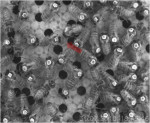Marker-assisted selection of the honey bee for Varroa tolerance by fine mapping and identification of causative genes in relevant genomic regions
| Funding code: | 2808HS009 |
| Acronym: | MOVA |
| Involved employees: | Dr. A. Spötter, Andrea Jäkisch, Prof. Dr. K. Bienefeld |
| Co-operation partners: | FBN Dummerstorf |
| Duration: | 2009 - 2012 |
| Financing: | German Federal Ministry for Consumer Protection, Nutrition and Agriculture (BMVEL) |
The trait "detecting and removing Varroa-parasitised brood" has proven itself promising in various working groups when selecting for Varroa tolerance. However, due to the significant time expenditure and cost of materials involved in its activity input, it cannot be integrated into practical breeding. By identifying trait-linked markers, or the underlying gene(s), the costly and environmentally dependent phenotypic trait detection can be marked down in practice. The identification of the hereditary basis leads to an improvement and acceleration in molecular breeding of populations, in that only animals with a high Varroa tolerance potential are admitted for breeding. According to Schaefer (2006), genome-based selection methods using SNPs (single nucleotide polymorphism) are still significantly more efficient than marker-assisted selection (MAS) using microsatellites. The aim of the project is the fine mapping of QTLs for Varroa-specific defence behaviour by means of SNP chip technology.
Publications:
- Spötter. A.; Gupta, P.; Nürnberg, G.; Reinsch, N.; Bienefeld, K. (2012) Development of a 44K SNP Assay focusing on the analysis of a varroa specific defense behavior in honey bees (Apis mellifera carnica) Molecular Ecology Resources 12(2), 323-332
- Gupta, P.; Conrad, T.; Spötter, A. Reinsch, N.; Bienefeld, K. (2012) Simulating a base population in the honey bee for molecular genetic studies. Genetics Selection Evolution 44, 14
- Gupta, P.; Reinsch, H.; Spötter, A.; Conrad, T.; Bienefeld, K. (2013) Accuracy of the unified approach in maternally influenced traits - illustrated by a simulation study in the honey bee (Apis mellifera). BMC Genetics 14, 36 DOI: 10.1186/1471-2156-14-36
- Application of marker-assisted selection for Varroa tolerance in the honey bee
- Utilisation of gene expression differences in hygienic and non-hygienic working bees towards Varroa-parasitised brood for the selection of generally disease-resistant honey bees
- Marker-assisted selection of the honey bee for Varroa tolerance by fine mapping and identification of causative genes in relevant genomic regions


